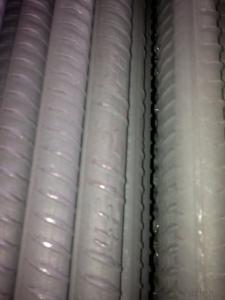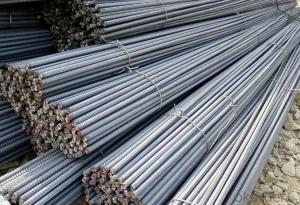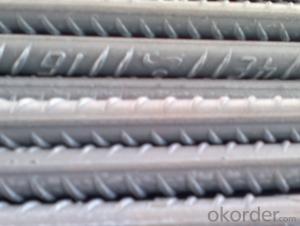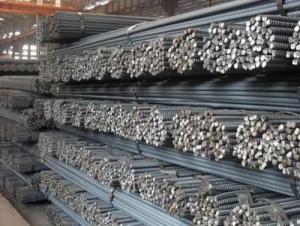GB/UK/USA STANDARD Deformed Steel Bar
- Loading Port:
- China Main Port
- Payment Terms:
- TT or LC
- Min Order Qty:
- -
- Supply Capability:
- -
OKorder Service Pledge
OKorder Financial Service
You Might Also Like
Product Description:
OKorder is offering GB/UK/USA STANDARD Deformed Steel Bar at great prices with worldwide shipping. Our supplier is a world-class manufacturer of steel, with our products utilized the world over. OKorder annually supplies products to European, North American and Asian markets. We provide quotations within 24 hours of receiving an inquiry and guarantee competitive prices.
Product Applications:
GB/UK/USA STANDARD Deformed Steel Bar are ideal for structural applications and are widely used in the construction of buildings and bridges, and the manufacturing, petrochemical, and transportation industries.
Product Advantages:
OKorder's GB/UK/USA STANDARD Deformed Steel Bar are durable, strong, and resist corrosion.
Main Product Features:
· Premium quality
· Prompt delivery & seaworthy packing (30 days after receiving deposit)
· Corrosion resistance
· Can be recycled and reused
· Mill test certification
· Professional Service
· Competitive pricing
Product Specifications:
Specifications of Deformed Steel Bar:
Standard | GB | HRB335, HRB400, HRB500 | |
UK | G460B, B500A, B500B,B500C | ||
USA | GR40, GR60 | ||
Diameter | 6mm,8mm,10mm,12mm,14mm,16mm,18mm,20mm, 22mm,25mm,28mm,32mm,36mm,40mm,50mm | ||
Length | 6M, 9M,12M or as required | ||
Place of origin | China mainland | ||
Application | building,construction,road,bridge etc | ||
Brand name | DRAGON | ||
Theoretical weight and section area of each diameter as below for your information:
Diameter(mm) | Section area (mm²) | Mass(kg/m) |
6 | 28.27 | 0.222 |
8 | 50.27 | 0.395 |
10 | 78.54 | 0.617 |
12 | 113.1 | 0.888 |
14 | 153.9 | 1.21 |
16 | 201.1 | 1.58 |
18 | 254.5 | 2.00 |
20 | 314.2 | 2.47 |
22 | 380.1 | 2.98 |
25 | 490.9 | 3.85 |
28 | 615.8 | 4.83 |
32 | 804.2 | 6.31 |
36 | 1018 | 7.99 |
40 | 1257 | 9.87 |
50 | 1964 | 15.42 |
Usage and Applications of Deformed Steel Bar:
Deformed bar is widely used in buildings, bridges, roads and other engineering construction. Big to highways, railways, bridges, culverts, tunnels, public facilities such as flood control, dam, small to housing construction, beam, column, wall and the foundation of the plate, deformed bar is an integral structure material. With the development of world economy and the vigorous development of infrastructure construction, real estate, the demand for deformed bar will be larger and larger..
Packaging & Delivery of Deformed Steel Bar:
Packaging Detail: products are packed in bundle and then shipped by container or bulk vessel, deformed bar is usually naked strapping delivery, when storing, please pay attention to moisture proof. The performance of rust will produce adverse effect.
Each bundle weight: 2-3MT, or as required
Payment term: TT or L/C
Delivery Detail: within 45 days after received advanced payment or LC.
Label: to be specified by customer, generally, each bundle has 1-2 labels
Trade terms: FOB, CFR, CIF
Deformed Steel Bar in Coil
Produce Line of Deformed Steel Bar
Note:
1. Our products are produced according to national standard (GB), if not, supply according to national standards (GB) or agreement as customer required.
2. Other Grade and Standard Deformed Steel Bar we can supply:
Grade: GR40/GR60, G460B/B500A/B500B/B500C,BST500S
Standard: ASTM, BS, DIN
The Minimum Order Quantity of these products is high, and need to be confirmed.
3. We can not only supply Deformed Steel Bar; if you need anything about building materials, please contact us for further information.
4. Please send us your detail specifications when inquire. We will reply to you as soon as possible. We sincerely hope we can establish a long stable business relationship
FAQ:
Q1: Why buy Materials & Equipment from OKorder.com?
A1: All products offered byOKorder.com are carefully selected from China's most reliable manufacturing enterprises. Through its ISO certifications, OKorder.com adheres to the highest standards and a commitment to supply chain safety and customer satisfaction.
Q2: How do we guarantee the quality of our products?
A2: We have established an advanced quality management system which conducts strict quality tests at every step, from raw materials to the final product. At the same time, we provide extensive follow-up service assurances as required.
Q3: How soon can we receive the product after purchase?
A3: Within three days of placing an order, we will begin production. The specific shipping date is dependent upon international and government factors, but is typically 7 to 10 workdays.
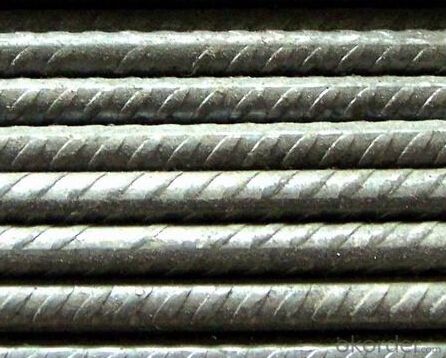

- Q:Can steel rebars be used in earthquake-prone regions?
- Yes, steel rebars can be used in earthquake-prone regions. Steel rebars are commonly used in construction to reinforce concrete structures, including buildings and bridges, to enhance their strength and durability. In earthquake-prone regions, where the risk of seismic activity is higher, steel rebars play a crucial role in providing additional support and resistance against the forces generated during an earthquake. The flexibility and ductility of steel rebars allow them to absorb and dissipate seismic energy, reducing the risk of structural failure and collapse. Therefore, incorporating steel rebars in construction practices is essential for ensuring the safety and resilience of buildings in earthquake-prone regions.
- Q:Are there any codes or regulations for the use of steel rebars in construction?
- Yes, there are codes and regulations that govern the use of steel rebars in construction. These codes provide guidelines for the design, fabrication, and installation of rebars to ensure structural integrity and safety in buildings and other structures. Some commonly used codes include the American Concrete Institute (ACI) 318, British Standards (BS) 8666, and the European Standard (EN) 1992-1-1. Compliance with these codes is essential to meet the required standards and regulations in the construction industry.
- Q:Are steel rebars suitable for use in structures with high wind loads?
- Structures with high wind loads can benefit from the use of steel rebars. Also known as reinforcing bars, steel rebars are commonly utilized in construction to provide strength and stability to reinforced concrete structures. Their purpose is to withstand significant tensile forces and play a crucial role in maintaining the structural integrity of buildings, particularly in areas prone to high wind loads. Steel rebars possess several advantages that render them suitable for structures with high wind loads. Firstly, steel exhibits exceptional tensile strength, enabling it to resist the forces generated by wind loads. Unlike materials such as timber or concrete, steel rebars possess remarkable ductility, allowing them to absorb and redistribute the energy produced by wind-induced vibrations. Secondly, steel rebars demonstrate remarkable durability and resistance to corrosion. This characteristic is vital for structures exposed to harsh weather conditions, including strong winds. Utilizing steel rebars mitigates the risk of structural deterioration or weakening over time caused by wind-induced stresses. Furthermore, steel rebars offer ease in molding and shaping, accommodating the specific design requirements of the structure. This flexibility empowers engineers to create and construct buildings capable of withstanding various wind loads experienced in different regions. In conclusion, due to their high tensile strength, durability, and resistance to corrosion, steel rebars are an ideal choice for structures with high wind loads. They provide the necessary reinforcement to ensure the longevity and safety of the structure under challenging wind conditions.
- Q:What are the guidelines for the proper cover thickness of steel rebars?
- To guarantee the durability and strength of reinforced concrete structures, guidelines have been established to determine the appropriate thickness of steel rebars used in their construction. The term "cover thickness" refers to the distance between the outer surface of the rebar and the concrete edge or surface. The specific guidelines for cover thickness may differ depending on factors such as design requirements, environmental conditions, and the intended purpose of the structure. Nevertheless, there are generally accepted minimum values for cover thickness as outlined in various international building codes and standards. The primary objective of maintaining sufficient cover thickness is to shield the steel rebars from corrosion caused by environmental elements like moisture, carbonation, and chloride ingress. Corrosion can significantly weaken the rebars, compromising the structural integrity of the reinforced concrete. The recommended minimum cover thickness for steel rebars is determined based on the exposure conditions. For instance, in regular environmental conditions, a minimum cover thickness of 25mm to 40mm is usually specified. However, in more aggressive environments, such as coastal areas with high chloride content or structures in contact with soil, a greater cover thickness of 50mm or more may be necessary. Adhering to these guidelines is crucial to ensure the long-term durability and safety of the structure. Insufficient cover thickness can accelerate the corrosion of the rebars, resulting in reduced load-bearing capacity, cracks, and ultimately, structural failure. Therefore, it is essential to consult the relevant building codes, standards, and design professionals to determine the appropriate cover thickness for steel rebars in a specific construction project.
- Q:What are the different methods for cutting steel rebars on-site?
- Cutting steel rebars on-site can be achieved using various methods, which depend on the specific project requirements and limitations. The following are some commonly used techniques: 1. For smaller projects or areas where power tools are inaccessible, manual cutting proves to be a suitable method. Handheld manual tools like rebar cutters or bolt cutters are utilized to cut through the steel rebars. 2. Abrasive cutting, also known as grinding or cut-off saws, employs a high-speed rotating disc with abrasive particles that grind through the steel rebars. This method is effective for cutting rebars of different sizes and is frequently employed on construction sites. 3. Torch cutting involves the use of oxy-fuel or plasma torches. The method entails heating the steel rebars to a high temperature and then cutting through them using the intense heat. Torch cutting is ideal for thicker and larger rebars, although caution and safety measures must be observed due to the open flame involved. 4. Shear cutting utilizes hydraulic or mechanical shears to cut through the steel rebars. It is an efficient method for quickly and accurately cutting rebars, particularly for larger projects. 5. Hydraulic cutting involves the use of hydraulic pumps to generate high pressure, which is then utilized to power the cutting blade. This method is commonly employed for heavy-duty cutting tasks and can easily cut through thick rebars. 6. Electric cutting is achieved using electric cutters, such as electric rebar cutters or portable band saws. These tools are powered by electricity and provide a clean and precise cut. They are commonly utilized on construction sites where power is readily available. When selecting the appropriate method for cutting steel rebars on-site, it is crucial to consider the specific project requirements, including the size and thickness of the rebars, available power sources, and safety considerations.
- Q:Can steel rebars be used in structures with high vibrations?
- Yes, steel rebars can be used in structures with high vibrations. Steel rebars have excellent mechanical properties, including high tensile strength and durability, making them suitable for reinforcing structures that experience vibrations. Additionally, steel rebars provide stability and help to distribute the vibrations throughout the structure, reducing the risk of failure due to excessive movement.
- Q:What are the different types of corrosion protection for steel rebars?
- There are several types of corrosion protection for steel rebars, including epoxy coatings, galvanization, concrete cover, and corrosion inhibitors.
- Q:How do steel rebars affect the overall sustainability of a construction project?
- Steel rebars can have a significant impact on the overall sustainability of a construction project. Firstly, steel rebars are commonly used to reinforce concrete structures, enhancing their strength and durability. By increasing the longevity of the building, steel rebars help minimize the need for frequent repairs or replacements, reducing the consumption of materials and energy required for maintenance over the long term. Moreover, steel rebars contribute to the structural integrity of a construction project, allowing for the design of lighter and more efficient structures. This results in reduced material usage, as well as lower energy consumption during the construction process. Additionally, the use of steel rebars can often lead to the construction of slimmer and more aesthetically appealing structures, which can have a positive impact on the environmental footprint of the project. Steel rebars are also recyclable, which further enhances the sustainability of a construction project. At the end of a building's life cycle, steel rebars can be easily recovered and reused, reducing the demand for new steel production. Recycling steel rebars not only conserves natural resources but also significantly reduces greenhouse gas emissions associated with the steel manufacturing process. Furthermore, steel rebars can contribute to the overall sustainability of a construction project by improving the building's resilience to natural disasters such as earthquakes or hurricanes. By providing additional strength and flexibility to the structure, steel rebars can help minimize damage and potentially save lives. In summary, steel rebars positively impact the overall sustainability of a construction project by enhancing the structural integrity and durability of buildings, reducing material and energy consumption, promoting recycling and reuse, and improving resilience to natural disasters. Their usage is a crucial component in creating more sustainable and environmentally friendly construction practices.
- Q:What is the process of removing steel rebars from concrete structures?
- The process of removing steel rebars from concrete structures typically involves several steps. First, the concrete surface around the rebar is often chipped away using pneumatic tools or jackhammers to expose the steel. Then, an oxyacetylene torch or a cutting disc is used to cut the rebar into smaller, more manageable pieces. If the rebar is embedded deep within the concrete, a core drilling machine may be used to create a hole around the rebar, allowing for easier removal. Finally, once the rebar is cut or loosened, it can be extracted using heavy machinery or manual labor, depending on the size and weight of the rebar.
- Q:Are steel rebars resistant to chemicals?
- Steel rebars are typically resistant to chemicals. Steel is renowned for its strength and durability, enabling it to endure exposure to various chemicals without significant deterioration. However, the level of resistance may vary based on the specific chemical, concentration, and duration of exposure. Generally, steel rebars exhibit high resistance to commonly found construction materials and environments, including water, concrete additives, and standard cleaning agents. They also withstand acids, alkalis, and organic solvents. Nevertheless, aggressive chemicals like strong acids or oxidizing agents can lead to corrosion or damage over time. Therefore, it is crucial to consider the chemical environment when choosing and utilizing steel rebars, and implement appropriate safeguards if necessary, such as protective coatings or corrosion inhibitors.
1. Manufacturer Overview |
|
|---|---|
| Location | |
| Year Established | |
| Annual Output Value | |
| Main Markets | |
| Company Certifications | |
2. Manufacturer Certificates |
|
|---|---|
| a) Certification Name | |
| Range | |
| Reference | |
| Validity Period | |
3. Manufacturer Capability |
|
|---|---|
| a)Trade Capacity | |
| Nearest Port | |
| Export Percentage | |
| No.of Employees in Trade Department | |
| Language Spoken: | |
| b)Factory Information | |
| Factory Size: | |
| No. of Production Lines | |
| Contract Manufacturing | |
| Product Price Range | |
Send your message to us
GB/UK/USA STANDARD Deformed Steel Bar
- Loading Port:
- China Main Port
- Payment Terms:
- TT or LC
- Min Order Qty:
- -
- Supply Capability:
- -
OKorder Service Pledge
OKorder Financial Service
Similar products
New products
Hot products
Hot Searches
Related keywords
